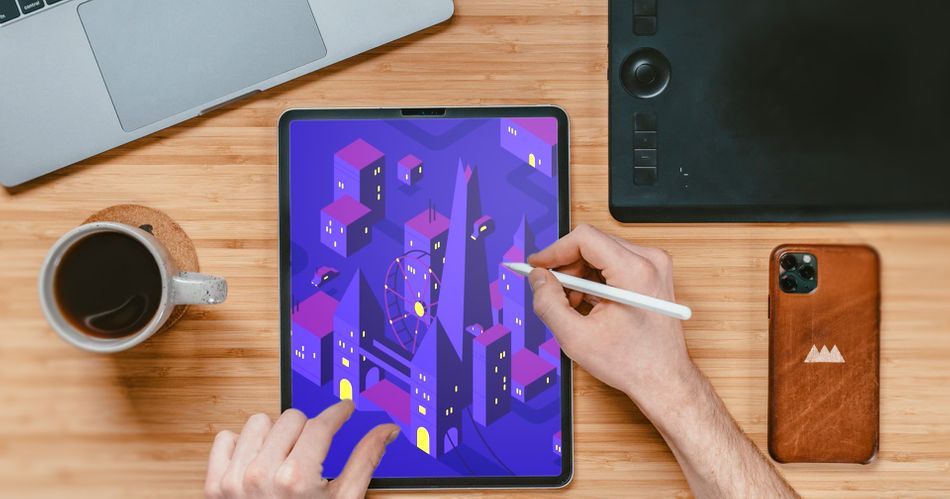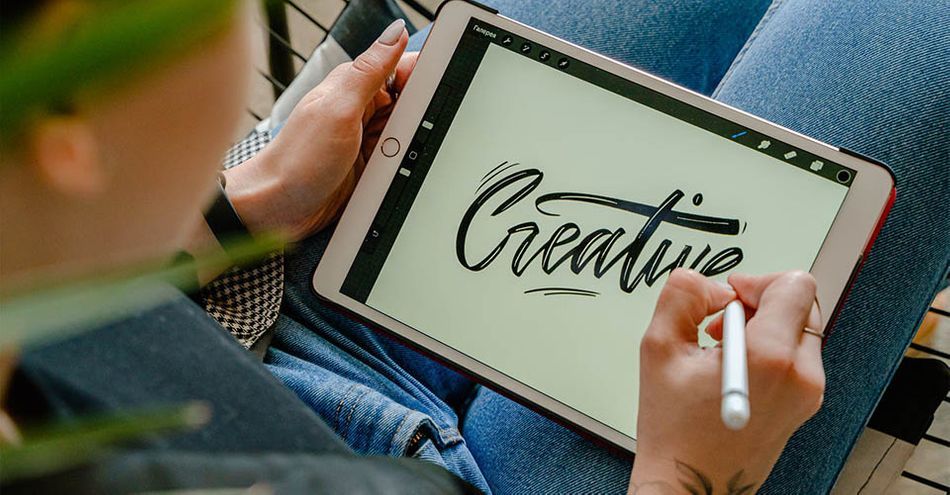
Welcome to the digital art revolution. Are you ready to begin?
Art, they say, is in the eye of the beholder. That's why one artist's screensaver can become some collector's $3.5 million NFT. We are in a booming market of incredible Digital Art, watching some of the most talented people on the planet finally get the recognition they deserve. From the outside, it's easy to feel overwhelmed. But this revolution is for everyone. Are you ready to join?

When Beeple (aka Mike Winkelmann) is featured on MSNBC and roasted on The Tonight Show, you know that we are living in strange times for Digital Artists. A talent that has long been a side-hustle for Graphic, Motion, and VFX designers is taking over the art world. What does that mean for you? For the digital art market? And how can you get started now that this train has already left the station?
Step out of the bitcoin mines for minute and let's talk about how to get started in Digital Art.
What is Digital Art?
The term "Digital Art" is a fairly broad term, and the styles we're discussing began in the early 1960s. Then called "computer art," multimedia art," or "cyber art," these pieces were mostly designed and planned using traditional methods of pen and paper. The artist would then use various tools and technology to enhance the final product into something abstract and visceral.
Artists such as George Nees used algorithms to create beautiful artwork based off complex calculations. These prints demonstrated complicated vectors that would be incredibly labor intensive for a person to produce manually.

Other artists, such as Desmond Paul Henry, used computers to calculate colorful overlapping geometric illustrations that evoke the Spirograph.

One of the most famous digital artists was renowned Pop Artists Andy Warhol, who created a series of digital pieces on an Amiga 1000 personal computer. The images included doodles and revisitations of Warhol's existing artworks, such as the Campbell's soup can and Botticelli's The Birth of Venus.

With the proliferation of digital art software, the industry saw programs designed to mimic the styles and tools of the physical art world. Digital brushes could simulate using a variety of paints, oils, watercolors, and pencils. As the software grew more sophisticated, so too did the artwork. Comic book, storyboard, and concept artists started incorporating digital tools into their workflow, expanding their possibilities and styles across multiple mediums.
With the world growing more and more connected, and these digital tools proliferating, the art world opened up to a global audience. This gave talented digital painters a global audience.
Today, Digital Art refers to a number of styles ranging from photo manipulation and traditional 2D all the way to moving, 3D images and virtual reality.
What are the Different Types of Digital Art?
This is a loaded question, and the answer we provide today will probably be outdated in a year or so. If you're looking to get into digital art, there are a huge number of fields to explore.
FRACTAL/ALGORITHMIC ART

Fractal art is a form of algorithmic art created by calculating fractal objects and applying the math to images, animations, and video. Similar to Desmond Paul Henry's art in the 60s, these images evoke a balance of nature and technology.
DATA-MOSHING
As more and more artwork went digital, artists noticed the somewhat common effect of glitching and corrupted image files...and how interesting and effective they could be. This led to intentionally corrupting, or moshing, data files to create psychedelic visuals.
DYNAMIC PAINTING
Have you ever seen a painting and swore it was moving? That the eyes were following you? That the water was really lapping at the shore? Dynamic painting combines the traditional methods of implying motion through brush strokes and color and combines it with actual motion via animation. The results are stunning.
2D/3D GRAPHIC ART AND PAINTING
This is where a lot of modern digital artists land. Graphic art is, simply put, art pieces created using digital tools. This can be character studies, landscapes, concept art, comic books, and many others. The use of digital tools allows for a level of precision that traditional pen and paper art does not.

In addition, digital art is often treated with a number of filters and effects to take full advantage of the digital toolset.
3D art and paintings can be all of this and more. Beeple's Everydays fit into this category, and you can see similar images from artists all around the world. They can be traditional or countercultural; evocative and even taboo. This artwork is created using 3D software, from Blender and ZBrush to Cinema 4D.
PIXEL ART
Pixel Art has been exploding in recent years, thanks in large part to the growing number of indie video games designed in this unique retro style. Harkening back to the heyday of Mario Brothers and Burger Time, this style takes complex scenes and expresses them in 8 / 16 / or 32-bit moving images.

This may sound simplistic, but it is anything but. Pixel artists are creating captivating, moving pieces pixel by literal pixel, and the results speak for themselves.
PHOTO MANIPULATION
This art style comes from the manipulation and alteration of digital images using a variety of software, most commonly Adobe Photoshop. While it is one of the most common types of digital art, it is by no means an easy feat. When you see a manipulation that truly understands the craft, you'll understand how effective this style can be.
And there are new methods arriving all the time. As soon as a new piece of software hits the market, there is another way to generate digital art.
How to Get Started in Digital Art

So now we've got your attention, and it's clear that digital art is sticking around, how can you get started? First of all—that's a great idea! We'll get into the why's of digital art in the next section, but trust that you are taking the first step in a journey that is incredibly rewarding.
First thing's first. You're going to need the right tools:
You can absolutely get started in digital art with just a mouse and keyboard, but we cannot stress how much better things get once you switch to a stylus and tablet. It is a much more intuitive experience.
The easiest way to get started is, no joke, with an iPad. Apple's tablet has a huge selection of applications specifically designed for creating digital art. Check out the link above for some of our favorites, including a number of free programs.
If you're sticking to a laptop or desktop, we can vouch for Wacom's excellent lineup of drawing tablets to get started. The Wacom One is an outstanding draw-on screen for an unbeatable price at $399.
DIGITAL ART SOFTWARE

Whether you're working with a tablet or not, you need some software to really get going. There are a few programs we always recommend, depending on what type of art you wish to create.
There are a TON of programs out there, and it's all about finding the one that works for you. If you have an iPad, we strongly recommend Procreate. It is an insanely powerful application that can easily export to Photoshop. If you're ready to put a little money down, Adobe Photoshop is one of the most commonly used programs in the world, and the resources available are endless.
Still, it's all about how you use the tool, not which tool you use. Check out the link for MS Paint if you don't believe us.
Why Should You Get Into Digital Art?
Why create art at all? Well, that's a personal question. Everyone has their own reason for diving into the art world. In technical terms, we usually divide art into "object focussed" or "process focussed." Basically, this means you are either creating art for the final product, or you're creating art for what the process does for you (and your audience).
CREATIVE EXPRESSION

The simplest reason is often the most important. Creating art is an amazing way to express yourself creatively. It can be extremely therapeutic, a way for you to explore complex emotions and share them in new and exciting ways.
Creating artwork forces you to focus on a single task for a period of time, and that mental exercise can be liberating. Even if you don't often show your work to others, there is a point of pride that comes with having created something yourself.
CAREER OPPORTUNITIES

There are literally tens of thousands of jobs in the U.S. alone that require some skill in digital art. From character creators and animators to asset design and world building, digital artists are in every single visual arts industry. Graphic designers are also needed...well, basically everywhere. Any company looking to piece together a brochure or new logo or ad campaign needs a digital artist to bring the design together.
If you want to see some of the jobs we're recommending, you can always check out our Creative Career page.
THE DIGITAL AUCTION HOUSE

Many of you will have heard of the digital art revolution sweeping through the art world right now. Beeple's meteoric rise over the past year has artists around the globe itching to mint a new NFT and cash in on all their hard work.
While it is very true that digital art can be a lucrative skill to market, you have to remember that there are a LOT of digital artists out there. The competition is stiff, so there is no guarantee that you'll make your millions selling that GIF of a donut eating a glazed person. We're not saying you shouldn't try, but treat it the same as you would trying to break in to the traditional art world. It's a marathon, not a sprint.
Is it worth your time to learn Digital Art?

Short answer? Yes.
Longer answer? YEEEEEEEEEEEEES!
Okay, real talk time. I got into digital art very late in life. I'd already trained in a number of careers before I really put in the time and effort to learn this new skill. Sure, I'd doodled on my notebooks back in school, but I didn't put in the time to study and grow as an artist until fairly recently. Now, a few years in, I can say this is one of the most rewarding experiences I've found.
Art is an act of expression, it is a way to connect with a global community of incredibly talented people.
If you never sell a single piece of your digital art, I can still say this is a worthy expense of your time. Now, if you decide to mint an NFT and place it out into the world for sale...well, that journey can be a bit longer. Unless your art is able to stand out from the market, it might take time before you sell even a single piece...and it might not go for as much as you'd hoped. Don't stress. Rome wasn't built in a day. Beeple worked for over TEN YEARS before blowing up the art world.
And if you have questions, we are always here. School of Motion was founded to break down the barriers to motion design, and we put artists first at every turn. If you want to grow into this wonderful world, we are here to help.
CHECK OUT SOME OF OUR OTHER ARTICLES ON DIGITAL ART!
- What is Crypto Art?
- Digital Art's New Frontier
- Interview with Digital Artist Beeple
- We Need to Talk About NFTs











